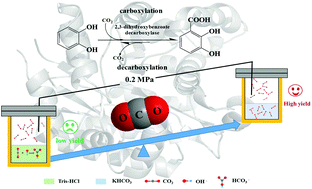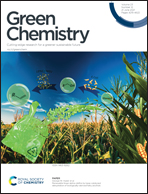CO2(aq) concentration–dependent CO2 fixation via carboxylation by decarboxylase†
Abstract
Enzymatic carbon fixation is one of the most interesting processes in CO2 sequestration. A number of decarboxylases can catalyze the reversible decarboxylation reaction in vivo, while can strengthen the carboxylation reaction in vitro. The Bio-Kolbe–Schmitt reaction is the carboxylation of phenols and CO2 by hydroxybenzoic acid decarboxylases to generate hydroxybenzoic acids under a mild condition, which requires an alkaline environment. It remains unclear how the carbon fixation via carboxylation can be improved. In this study, the major issues regarding the switching from decarboxylase to carboxylase through thermodynamic calculation and determination of enzyme characteristics, CO2 concentration, and other related species in the reaction system such as HCO3− are described. We identified that the concentration of CO2 in aqueous solution was the main factor for obtaining high CO2 fixation yield. In order to obtain sufficient CO2(aq) to promote the carboxylation by decarboxylase under an alkaline environment, a high concentration of HCO3− is required. The highest CO2 fixation yield of 30% was achieved from the reaction under 0.2 MPa CO2 in 2.7 M KHCO3 buffer for 15 min. Under the optimal reaction conditions, the carboxylation of catechol by 2,3-DHBD_Ao (2,3-dihydroxybenzoic acid decarboxylase from Aspergillus oryzae) achieved a good “turnover frequency” (TOF) of 47 min−1. This study discloses that CO2(aq) concentration is a crucial parameter for increasing CO2 fixation yield in a homogenous reaction under an alkaline condition.



 Please wait while we load your content...
Please wait while we load your content...